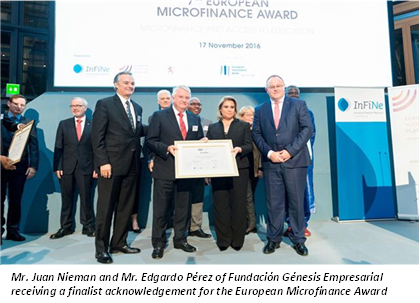In 2010, Omtrix, a microfinance fund manager based in Costa Rica, saw that the greatest barriers to higher education for low-income youths was lack of access to financing. Omtrix wondered if this need could be met by microfinance institutions. Serving this sector would certainly meet their mandates, and MFIs already knew how to reach and serve low-income people. Omtrix hypothesized that under the right conditions, and with the right approach, student loans could be a viable product for MFIs.
They decided to create a new fund to promote higher education. The new fund, called The Higher Education Finance Fund (HEFF), would lend to MFIs so that they could in turn on-lend to bright young people whose aspirations lay beyond their financial reach. HEFF’s funding would be accompanied by a technical assistance program to train MFI staff in how to appraise, monitor, and collect on student loans, as well as offer other tools to launch a new product. Additionally, HEFF would serve as a pilot program to be replicated by other MFIs or funds in the future and across the globe.
 HEFF began operations in late 2011, and by mid-2017 the US$33 million fund has funded around 5,000 low-income students in 7 LAC countries through 10 socially-motivated financial institutions (FIs). Through its $1.6 million technical assistance facility (TAF), over 800 personnel have been trained in student lending methodologies. The fund has disbursed $24 million, and will continue funding new students through 2022. In 2016, one of HEFF’s portfolio MFIs, Génesis Empresarial (Guatemala) was named a finalist for the European Microfinance Award in recognition of its work in promoting education to low-income youths.
HEFF began operations in late 2011, and by mid-2017 the US$33 million fund has funded around 5,000 low-income students in 7 LAC countries through 10 socially-motivated financial institutions (FIs). Through its $1.6 million technical assistance facility (TAF), over 800 personnel have been trained in student lending methodologies. The fund has disbursed $24 million, and will continue funding new students through 2022. In 2016, one of HEFF’s portfolio MFIs, Génesis Empresarial (Guatemala) was named a finalist for the European Microfinance Award in recognition of its work in promoting education to low-income youths.
Over the past six years, HEFF’s original assumptions have been tested, and the innovative program has experienced some growing pains. Omtrix has begun the process of capturing lessons learned and best practices to disseminate those lessons to anyone who may want to replicate or build on HEFF’s model. In 2016, Omtrix published Cross Fertilization Workshop in Student Lending: Lessons Learned, a paper which captures the experiences, challenges, and best practices of HEFF’s FIs. In 2017, TAF funders commissioned a business case study to analyze the viability of student loans as a double-bottom line product.[1]
Most lessons learned challenge HEFF’s original assumptions. When HEFF’s student lending methodology was conceived, it was geared towards full-time students who recently graduated from secondary school. The loans would be long term, double the length of years of study. During higher education enrollment, students would only pay interest rates. After graduation, borrowers could opt for a grace period of up to six months between graduation and employment before starting to amortize the loan. It was also expected that FIs would market to children of existing clients in their portfolios.
In practice, the bulk of the methodology was sound, and adopted as-is. HEFF’s portfolio FIs were enthusiastic about the lending method, but soon after implementing the product discovered some snags in product launch. For example, credit officers were reluctant to experiment with the new student loan product, and busy managers couldn’t give student loans the attention necessary to grow a new portfolio. On the IT side, student loans required new forms and processes, and banking software wasn’t always readily modified. As for the clients, few were recent graduates or full-time students. The average age of HEFF’s student borrowers is 24, not 19, and most of them work full time and study nights and weekends. Often, clients struggled to adapt to the long terms of student loans, and preferred short, renewable loans without grace periods, preferring to begin paying back the loan immediately upon signing it. Market penetration proved a challenge as well. MFI’s initial expectations turned out to be optimistic and institutions had to penetrate a new market segment, but their traditional marketing methods failed to engage tech-savvy millennials.
 Some challenges were easier than others to address. Across the board, MFIs realized that they needed an internal champion, a person whose sole job is to grow the student loan portfolio without any other duties competing for their attention. This person needed to be empowered, heard, and given resources to implement their ideas both internally and externally. A few of HEFF’s participant FIs created specialized credit officer units that only placed student loans during the product launch phase.
Some challenges were easier than others to address. Across the board, MFIs realized that they needed an internal champion, a person whose sole job is to grow the student loan portfolio without any other duties competing for their attention. This person needed to be empowered, heard, and given resources to implement their ideas both internally and externally. A few of HEFF’s participant FIs created specialized credit officer units that only placed student loans during the product launch phase.
When reaching young adults, MFIs had to invest in social media marketing, and snazzy online videos that engage young people, while also educating them about the product. A real launch point for many institutions came when they formed alliances with popular universities and institutions so that prospective students were exposed to the MFI’s marketing materials while visiting the schools. HEFF helped MFIs meet these challenges by expanding TAF’s services to include funding for new marketing methods, and on-going consultant visits past initial training. These consultants had exposure to the solutions devised across HEFF’s MFIs, and shared those ideas with other MFIs facing the same challenges.
With the wisdom of hindsight, these adjustments seem obvious, but in practice, MFIs have fixed operational routines. The theory that a new product may seamlessly glide into place within that routine was quickly disproven. Developing and launching a new product is disruptive and requires focused attention, fresh approaches, a lot of experimentation, and a distilling and dissemination of the best solutions, which is what HEFF plans to do.
[1] For a copy of Cross Fertilization Workshop in Student Lending, email info@omtrixinc.com. The business case analysis will be published later this year.
Photo credit home page © World Bank/Dominic Chavez via Flickr


Leave a comment